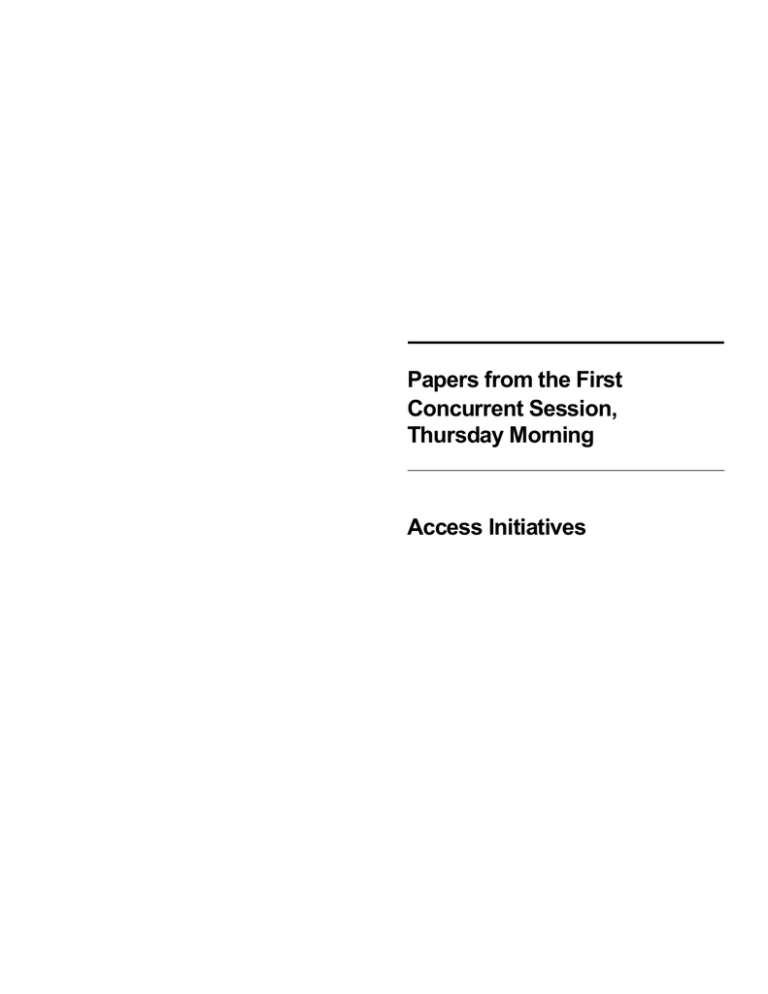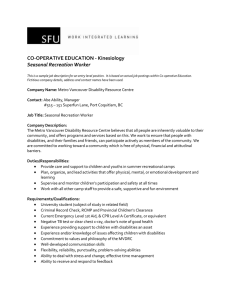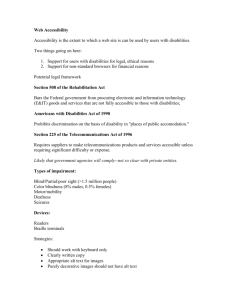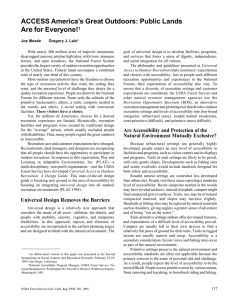Papers from the First Concurrent Session, Thursday Morning Access Initiatives
advertisement

Papers from the First Concurrent Session, Thursday Morning Access Initiatives National Research, Technology and Training: Implementing Recreation Design Concepts1 Edward J. Hamilton2 Abstract: These are exciting times. The changes that have occurred and that will occur for people with disabilities are of a magnitude similar to those changes occurring in Eastern Europe. The removal of physical and social barriers for people with disabilities are analogous to the removal of the Berlin Wall. As with the revolutionary changes occurring in Eastern Europe, the changes being wrought in the lives of people with disabilities in the United States are moving at a frantic pace, producing misinformation, misdirected efforts, and fears of what those changes will mean to the economy. The purpose of this paper is to discuss the means by which technology, research, and education begin to address the changes occurring in recreation for people with disabilities. Advances in rehabilitation engineering and other technology have increased remarkably in the past decade. The introduction of assistive listening devices, such as audio loops, infra red audio systems, and text telephones have increased program and communication opportunities for those who are deaf or hard of hearing. Voice activated computers and optic scanners have provided greater access and independence for people with visual impairments. Advances in wheelchair design and adaptive recreation equipment have provided independent access to backpacking, downhill skiing, fishing, and nearly every other type of recreational pursuit for people with mobility impairments. The eventual application of virtual reality computer technology may allow alternative access to remote outdoor areas and challenging outdoor experiences to people with the most severe disabilities. Although advances in technology have been abundant, application of that technology has been deterred by our ability to keep track of the changes, inflated costs, liability concerns, and the presence of inferior quality products. Overcoming these difficulties will require the development of technical resource centers for technical assistance. These clearinghouses will need to provide information on a variety of assistive devices, provide testing of various products, and provide cost comparisons. The National Center on Accessibility, located at Indiana University, is establishing such a clearinghouse specific to recreation, parks, and tourism. In addition, the National Institute on Disability and Rehabilitation Research has established regional centers for technical assistance throughout the United States. The research needs regarding accessible recreation are many. Although there are volumes of studies examining the recreation preferences, constraints, and behaviors of recreation users in the United States, there is a paucity of like research on people with disabilities. The research that does exist has often been plagued by small sample size, unrepresentative samples, inadequate meth1 Presented at the Symposium on Social Aspects and Recreation Research, February 19-22, 1992, Ontario, California. 2Assistant Professor and Director, National Center on Accessibility, Indiana University, Bloomington. 6 odology, and a lack of appreciation for the multi-dimensional nature of people with disabilities. There are, however, several exciting developments that are occurring in this area. Last year, the National Council on Disability contracted with Wilderness Inquiry to conduct a study of wilderness use by persons with disabilities. The study consisted of four parts: the first component surveyed over 500 wilderness managers from the USDA Forest Service, the National Park Service, the U.S. Fish and Wildlife Service, and the Bureau of Land Management to determine managers' attitudes toward providing access to wilderness areas for people with disabilities. The second component of the study involved an analysis of the policies of those four agencies related to people with disabilities and the wilderness. The third component surveyed 200 individuals with disabilities who were known to use wilderness areas to determine the frequency and locations of wilderness areas they had used, the degree of access to those areas, and their satisfaction with the experiences. The fourth component surveyed outdoor programs and outfitters who dealt with people with disabilities to assess their experiences with providing access to wilderness areas. The final draft of that study has been forwarded to the National Council on Disability for their review. Public release of the report is expected in Spring, 1992. The National Survey on Recreation and the Environment (NSRE) has been developed and is currently being piloted. The survey, which is sponsored by the several federal agencies, private organizations, and the National Center on Accessibility, seeks to examine the outdoor recreation pursuits, constraints, preferences, and concerns of the American public. The study is attempting to include a representative sample of people with disabilities. We will conduct 25,000 telephone surveys and follow-up mail surveys to those households identified as including a person with a disability. The study, which will be conducted during a 12 month period beginning in May, will provide valuable information to service providers. The importance of studies such these cannot be denied, nevertheless, there is also need for research of a different nature—research that experimentally tests the standards, guidelines, and concepts that have been developed for accessibility. For example, one of the assumptions of universal design is that a universal design is more effective and satisfying for everyone, not just people with disabilities. One of the studies to be conducted by the National Center on Accessibility is a comparison of able-bodied and disabled user satisfaction of campsites and lodging accommodations that have been developed with universal design principles. The results of the study could have significant implications for how we design all of our areas. Research is needed that will examine the relative effectiveness of various trail surfaces, in terms of usability by persons USDA Forest Service Gen. Tech. Rep. PSW-132. 1992. with mobility impairments, aesthetics, and maintenance. One of the most difficult problems in terms of access to outdoor recreation has centered on beach access. Which designs, materials, or assistive devices can most effectively provide access without negatively impacting on the environment. The recently completed Guidelines for the Design of Barrier-Free Recreational Boating and Fishing Facilities developed by the States Organization for Boating Access failed to adequately address this problem. Obtaining the knowledge that both technology and research can provide is only useful if it is utilized by all levels of service providers. The manager who has the knowledge and does not share that knowledge with his/her co-workers will fail to positively effect his agency's customers. Similarly, the maintenance personnel who understand the retrofit needs for accessibility and yet are not in position to influence financial decisions may be stifled in making change. Consequently, a multi-tiered program of education and information dissemination is needed. For the past 3 years, Indiana University, in cooperation with the National Park Service, has conducted such a multi-tiered education program. Thus far, four levels of education have been offered. The basic education program promotes understanding of the needs of people with disabilities, the legislation that protects their rights, and the minimal standards to assure physical access. A second level of education has been developed specifically for designers and architects to examine the design standards in more depth and to explore specific design issues. A third tier of education has been developed to examine the unique USDA Forest Service Gen. Tech. Rep. PSW-132. 1992. problems associated with retrofitting existing facilities and areas to make them accessible. This education is targeted to maintenance personnel. The fourth level of education has been designed for interpreters and programmers around the issues and problems associated with providing physical access to buildings and areas are much different than those associated with providing program access. Getting a blind person to the Statue of Liberty requires different skills than enabling a blind person to "see" the Statue of Liberty. A fifth level of education is being developed for implementation this summer. This program will be targeted to upper management. Finally, we must address what can be done to enable further development of technology, research, and education to facilitate greater inclusion of people with disabilities. None of us needs to be reminded that we live in very difficult financial times. These difficult financial times require us to manage our financial resources more effectively by maximizing opportunities for cooperation and collaboration. Nowhere are those opportunities more apparent than in research and education. Two of the projects referred to earlier are excellent examples of this cooperation. The NSRE is a collaborative research project of federal agencies, private organizations, and state universities. Similarly, the education programs offered by the National Center on Accessibility have been a cooperative effort of federal agencies, state agencies and Indiana University. If we are to successfully include people with disabilities, we must form more and stronger partnerships. 7





